
College Physics
11th Edition
ISBN: 9781305952300
Author: Raymond A. Serway, Chris Vuille
Publisher: Cengage Learning
expand_more
expand_more
format_list_bulleted
Concept explainers
Topic Video
Question

Transcribed Image Text:A 0.550 kg metal cylinder is placed inside the top of a
plastic tube, the lower end of which is sealed off by an
adjustable plunger. The cylinder comes to rest some
distance above the plunger. The plastic tube has an inner
radius of 5.54 mm and is frictionless. Neither the plunger
a
nor the metal cylinder allow any air to flow around them.
If the plunger is suddenly pushed upwards, increasing the
pressure between the plunger and the metal cylinder by a
factor of 2.31, what is the initial acceleration a of the metal
cylinder? Assume the pressure outside of the tube is
1.00 atm and that the top of the tube is open to the air.
a
m/s2
Expert Solution
This question has been solved!
Explore an expertly crafted, step-by-step solution for a thorough understanding of key concepts.
This is a popular solution
Trending nowThis is a popular solution!
Step by stepSolved in 3 steps

Knowledge Booster
Learn more about
Need a deep-dive on the concept behind this application? Look no further. Learn more about this topic, physics and related others by exploring similar questions and additional content below.Similar questions
- A vertical, frictionless piston-cylinder device contains a gas at 600 kPa absolute. The atmospheric pressure outside is 100 kPa absolute. The piston has a diameter of 50 mm. a) Determine the mass of the piston. b) If the mass of the piston is now halved ---- what would be the gauge pressure of the gas?arrow_forwardA 0.527 kg metal cylinder is placed inside the top of a plastic tube, the lower end of which is sealed off by an adjustable plunger. The cylinder comes to rest some distance above the plunger. The plastic tube has an inner radius of 6.56 mm and is frictionless. Neither the plunger nor the metal cylinder allow any air to flow around them. If the plunger is suddenly pushed upwards, increasing the pressure between the plunger and the metal cylinder by a factor of 1.35, what is the initial acceleration ? of the metal cylinder? Assume the pressure outside of the tube is 1.00 atmand that the top of the tube is open to the air.arrow_forwardA cylinder containing ideal gas is sealed by a piston that is above the gas. The piston is a cylindrical object, with a weight of 22.0 N, which can slide up or down in the cylinder without friction. The inner radius of the cylinder, and the radius of the piston, is 8.00 cm. The top of the piston is exposed to the atmosphere, and the atmospheric pressure is 101.3 kPa. The cylinder has a height of 30.0 cm, and, when the temperature of the gas is 20°C, the bottom of the piston is 11.0 cm above the bottom of the cylinder. (A) Find the number of moles of ideal gas in the cylinder. (B) Heat is added, gradually raising the temperature of the gas to 160°C. Calculate the distance between the bottom of the cylinder and the bottom of the piston when the piston comes to its new equilibrium position.arrow_forward
- A popular pool toy allows the user to push a plunger to compress water in a barrel with a diameter of 3.5 cm. The water is compressed with a speed of 1.9 m/s and emerges from a small opening with a speed of 12 m/s. What is the diameter (in mm) of the opening? Assume the toy is oriented horizontally. mmarrow_forwardTire gauges for air pressure, as well as most other gauges used in an industrial environment take into account the pressure due to the atmosphere of earth. That's why your car gauge reads 0 before you put it on your tire to check your pressure. That is called gauge pressure. The real pressure within a tire or other object contains pressurized stuff would be a combination of what the gauge reads as well at the atmospheric pressure. If a gauge on a tire reads 40.16 psi, what is the real pressure in the tire in pascals. The atmospheric pressure is 1.01x10^5 Pa.arrow_forwardYou fill a balloon with helium and let it go. It floats up into the air, where it is essentially floating in a pool of air. Why does the helium filled balloon float in air? Make sure you use the words ‘buoyancy’, ‘density’ and ‘volume of displaced ‘air’ in answering this question.arrow_forward
arrow_back_ios
arrow_forward_ios
Recommended textbooks for you
 College PhysicsPhysicsISBN:9781305952300Author:Raymond A. Serway, Chris VuillePublisher:Cengage Learning
College PhysicsPhysicsISBN:9781305952300Author:Raymond A. Serway, Chris VuillePublisher:Cengage Learning University Physics (14th Edition)PhysicsISBN:9780133969290Author:Hugh D. Young, Roger A. FreedmanPublisher:PEARSON
University Physics (14th Edition)PhysicsISBN:9780133969290Author:Hugh D. Young, Roger A. FreedmanPublisher:PEARSON Introduction To Quantum MechanicsPhysicsISBN:9781107189638Author:Griffiths, David J., Schroeter, Darrell F.Publisher:Cambridge University Press
Introduction To Quantum MechanicsPhysicsISBN:9781107189638Author:Griffiths, David J., Schroeter, Darrell F.Publisher:Cambridge University Press Physics for Scientists and EngineersPhysicsISBN:9781337553278Author:Raymond A. Serway, John W. JewettPublisher:Cengage Learning
Physics for Scientists and EngineersPhysicsISBN:9781337553278Author:Raymond A. Serway, John W. JewettPublisher:Cengage Learning Lecture- Tutorials for Introductory AstronomyPhysicsISBN:9780321820464Author:Edward E. Prather, Tim P. Slater, Jeff P. Adams, Gina BrissendenPublisher:Addison-Wesley
Lecture- Tutorials for Introductory AstronomyPhysicsISBN:9780321820464Author:Edward E. Prather, Tim P. Slater, Jeff P. Adams, Gina BrissendenPublisher:Addison-Wesley College Physics: A Strategic Approach (4th Editio...PhysicsISBN:9780134609034Author:Randall D. Knight (Professor Emeritus), Brian Jones, Stuart FieldPublisher:PEARSON
College Physics: A Strategic Approach (4th Editio...PhysicsISBN:9780134609034Author:Randall D. Knight (Professor Emeritus), Brian Jones, Stuart FieldPublisher:PEARSON

College Physics
Physics
ISBN:9781305952300
Author:Raymond A. Serway, Chris Vuille
Publisher:Cengage Learning

University Physics (14th Edition)
Physics
ISBN:9780133969290
Author:Hugh D. Young, Roger A. Freedman
Publisher:PEARSON

Introduction To Quantum Mechanics
Physics
ISBN:9781107189638
Author:Griffiths, David J., Schroeter, Darrell F.
Publisher:Cambridge University Press

Physics for Scientists and Engineers
Physics
ISBN:9781337553278
Author:Raymond A. Serway, John W. Jewett
Publisher:Cengage Learning

Lecture- Tutorials for Introductory Astronomy
Physics
ISBN:9780321820464
Author:Edward E. Prather, Tim P. Slater, Jeff P. Adams, Gina Brissenden
Publisher:Addison-Wesley

College Physics: A Strategic Approach (4th Editio...
Physics
ISBN:9780134609034
Author:Randall D. Knight (Professor Emeritus), Brian Jones, Stuart Field
Publisher:PEARSON